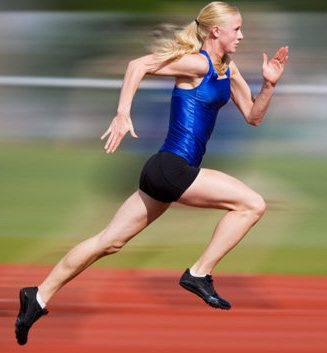 It never ceases to amaze me how complex the simple act of running can seem. We are after-all, apparently adapted to run. Human-primate differences such as the adaptation of the thumb-like grasping big toe to the stabilising human big toe, the development of the arched foot to absorb ground impact and the prominence of the human gluteus maximus compared to primates all suggesting an evolutionary preference for bi-pedal movement. As children we run without prompting, we run frequently, often without shoes, and we usually don’t get injured. So what changes in adulthood when, for many, running suddenly becomes a great challenge?
It never ceases to amaze me how complex the simple act of running can seem. We are after-all, apparently adapted to run. Human-primate differences such as the adaptation of the thumb-like grasping big toe to the stabilising human big toe, the development of the arched foot to absorb ground impact and the prominence of the human gluteus maximus compared to primates all suggesting an evolutionary preference for bi-pedal movement. As children we run without prompting, we run frequently, often without shoes, and we usually don’t get injured. So what changes in adulthood when, for many, running suddenly becomes a great challenge?
I would suggest that half of the ‘battle’ is efficiency. You probably wouldn’t enjoy cycling much if you always rode with the brake slightly engaged, or swimming if you always swam in your clothes. Done correctly, moderate running feels nearly effortless (though it does in fact offer great bang for your buck in terms of calories per hour). Efficiency is really just technique – for instance, there most definitely is a best technique to perform any weight lift in order to lift at your maximum. When it comes to running, the body’s most amazing ability, its ability to adapt the way it gets things done, is also its drawback. For most of us, adulthood means responsibility – work and duty. Natural play gives way to lots of sitting, and fast lifestyles heap stress, poor diet and lack of sleep into the equation. Muscles weaken and tighten, poor posture develops and in some cases some muscles forget how to activate altogether. We can run through these challenges, but the body will find a different, less efficient (read: more arduous and injury prone) way of getting the job done.
So re-learning how to run can make the process more efficient, as can correcting the postural imbalances and muscle problems (tightness, weakness, and lack of activation) which result from our lifestyles.
Enter the Gluteus Maximus (GMax)
It is possible to literally write a book about the various elements of an efficient running technique but if you wanted to start somewhere, this is it. The GMax originates from the sacrum (tail bone) and the bony ridge of the back of the hip which rises up out outwards from the sacrum (the ilium). It attaches along the top half of the femur and also into the illiotibial band, a fibrous band responsible for lateral knee stabilisation which runs down the outside of the thigh and inserts into the top of the tibia (shin bone).
The GMax extends the hip. In the running stride it pulls on the femur from the top of the forward leg swing, initiating the stride and producing the powerful kick-back motion. But it is not the only muscle which can perform this action. The hamstrings (semitendinosus, semimembranosus, and biceps femoris (long head)) can also extend the hip, and in fact, in low intensity hip flexion, they are the primary movers, with the GMax only really activating when the effort increases.
GMax activation
One problem with running technique often develops when we regularly sit for long periods and otherwise, apart from running, engage in mostly low intensity activity involving hip extension, such as walking. Everything in the body works on a ‘use it or lose principle’ and if the GMax is left deactivated for long periods of time, even the stimulus of running, by itself, will not be enough for the brain to remember how to send the correct nerve signal to activate the GMax. This is a major ‘bang for your’ thing to look at when working on your running technique – if you can wake up your GMax then it will contribute to a more powerful stride. Both hamstrings and GMax will work together to give you a stronger backwards leg swing.
GMax (re)activation can be achieved through weight/strength training. When you start lifting heavy things the first adaptation the body makes is neural, not muscular. Instead of significant muscle growth the first thing you’ll do is develop stronger neural activation pathways. The signals from the brain become more pronounced and precise and the innervation of the muscle improves, meaning new nerve endings will grow into the muscle fibres. The important thing to remember is that you want to specifically target the GMax muscles. Squats and deadlifts are generally great exercises for GMax but because many other muscles get involved, there is the potential, as in running, for other muscles to pick up the slack caused by glutes asleep on the job. Do these exercises by all means, but in your routine firstly start with some GMax isolation exercises, such as leg press with a high foot placement, cable kick-backs and elastic band donkey kicks. Go heavy and hit 5 sets of 4-5 reps, with a good rest in between. You want to feel reasonably fresh for each set. Come talk to me if you’d like to be shown through a good routine.
GMax inhibition
 The antagonist muscles of the GMax are the hip flexors – the iliacus, psoas major and psoas minor. These muscles produce the opposite of hip extension (flexion), and in the running stride are responsible for pulling the leg through the ‘recovery’ part of the stride. By definition, these muscles oppose the movement of the GMax but in practice they should relax enough during hip extension in order for the GMax to work effectively. But when they’re tight or poorly controlled (a neural activation issue) they are not able to relax properly. They maintain tension during hip extension and the GMax must ‘fight’ against them. This robs the GMax of its true, powerful potential in propelling you forward.
The antagonist muscles of the GMax are the hip flexors – the iliacus, psoas major and psoas minor. These muscles produce the opposite of hip extension (flexion), and in the running stride are responsible for pulling the leg through the ‘recovery’ part of the stride. By definition, these muscles oppose the movement of the GMax but in practice they should relax enough during hip extension in order for the GMax to work effectively. But when they’re tight or poorly controlled (a neural activation issue) they are not able to relax properly. They maintain tension during hip extension and the GMax must ‘fight’ against them. This robs the GMax of its true, powerful potential in propelling you forward.
Tight hip flexors are common, and again, often a result of sitting for long periods. If you have tight hip flexors and GMax’s which fail to activate properly, then its double trouble for your running technique. Stretch out the hip flexors often, including static stretches held for about 20 seconds in the morning and evening, and light ballistic stretches during your run warm up. The 90/90 lunge stretch is a good static stretch to introduce you (they’ll hurt!) and also helps you feel what your neutral pelvis position feels like. A more advanced option involves a long lunge with the rear foot raised, but because the psoas muscles pull on the vertebrae of the lower back, it is quite important to know how to position your hips and back safely. A good warm up ballistic stretch is simple leg swings. Start with a small swing arc and gradually increase it, aiming for about a 30 degree leg extension behind the body, as depicted in the diagram to the right.
The GMax powerband
All muscles have a section of their full range of movement (ROM) which is strongest. This has to do with how many actin-myosin cross bridges (tiny structures within muscles which pull against each other) are available at different stages of muscle lengthening or contraction. For most muscles, GMax included, the strongest section of ROM is the mid-section. The hips are capable of about 140 degrees of rotation, so the middle section of movement starts roughly 45 degrees from maximum flexion and continues through to about 95 degrees.
The picture below illustrates the theory beautifully. The green line depicts maximum flexion and the red line maximum extension. The blue arc is the mid-range for the GMax, and the most powerful section of its contraction.

What is notable here is that for distance running (as opposed to sprinting) the ideal starting point for the stride is the start of the GMax mid-range, and the ideal foot touchdown point is at the end of the GMax mid-range. That point is actually slightly in front of the body’s centre of gravity because the addition of slight knee flexion actually places the foot directly under the centre of gravity, as seen with the runner second from the right. At this point the femur (thigh bone) is rotating underneath the body as quickly as possible and then knee extension and plantar flexion (pointing the toe) are added into the movement to assist with a powerful ‘toe-off’.
Problems arise when the pelvis is not in a neutral position. Anterior (forward) tilt is far more common than posterior (rear) tilt, often a result of tight hip flexors caused by, you guessed it, too much sitting! A tilted pelvis will shift the blue arc backwards (anterior tilt) or forwards (posterior tilt). Either way, both prevent the GMax from pushing through its powerful mid-range throughout the entire first section of stride from start to foot touchdown – the GMax is not utilised to its full potential.
To address this problem there are a range of exercises involving a fit ball which help to improve your awareness of the position of the hips. You want to get to the point where hip position is set unconsciously with proprioception, as opposed to consciously. This is because running is a very dynamic activity and it is hard to correctly self-monitor hip position while running, especially when you add the required forward body tilt in (see the picture above, where the solid yellow line shows a neutral pelvis which is actually angled downwards slightly, due only to the runner’s forward lean). Come and talk to me if you think this is a problem for you – a spotter is far better than self-assessment.
Power up your running
Let’s face it, going fast is fun, especially when it doesn’t feel like you’re dragging a parachute behind you. So if you find running challenging and are mystified as to how some people can easily glide along at your top pace, consider how effectively your GMax’s are working for you.
Jordan Ralph
Conan Trainer, avid runner
Download Article: Jordan – The Running Powerhouse





